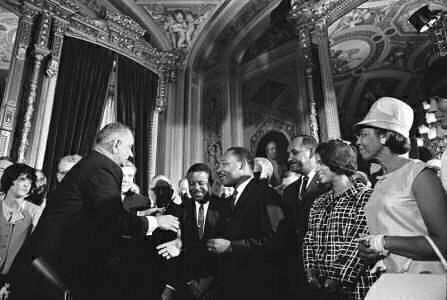On August 6, 1965, President Lyndon Johnson signed the landmark Voting Rights Act, a centerpiece of the civil rights movement that is still the subject of debate.

The Voting Rights Act’s origins were in the 15th Amendment’s 1870 ratification. “The right of citizens of the United States to vote shall not be denied or abridged by the United States or by any State on account of race, color, or previous condition of servitude,” read the amendment’s first section.
However, Reconstruction’s end in 1877 with the “Compromise of 1877” led to an era where mostly former Confederate states used violence, intimidation, legal maneuvers, and poll taxes to keep African-Americans away from the polls.
By the 1940s, a series of court decisions and Congressional acts started to wear down these tactics. In 1962, the Supreme Court decided in Baker v. Carr that the federal courts could intervene in state voter reapportionment cases. And in Reynolds v. Sims (1964), the Court upheld the idea of one person, one vote, and equal representation in state legislatures based on population.
Still, violence persisted in the states where Black people were continually blocked from voting. Then, on March 7, 1965, civil rights activists were attacked by Alabama police near a bridge in Selma, Alabama, in a moment that shocked a nation and helped lead to the Voting Rights Act.
A crowd of about 600 people had gathered near the Edmund Pettus Bridge to start a 54-mile march to Montgomery, Alabama, aiming to raise awareness about the killing of Jimmie Lee Jackson. Jackson had been shot three weeks earlier by an Alabama state trooper while protecting his mother during a voting rights march.
Led by Hosea Williams and John Lewis, the group walked over the Pettus Bridge toward Montgomery. In full view of journalists and photographers, the group was then attacked by Alabama state police and a posse acting under the orders of Alabama Governor George Wallace. The police gave the group two minutes to leave the scene; the protesters opted to pray. The violent events that followed soon became known as “Bloody Sunday.”
Absent from the first march was Martin Luther King Jr., who was at his Atlanta church at the time. King quickly told reporters that he was heading to Selma to lead a second march. King also said he would seek restraining orders against Wallace and state police in federal court.
The second march at Selma on March 9 was short and ceremonial, as civil rights leaders waited for legal support. Dr. King led marchers over the Pettus Bridge and back to a church where the march began. Tragically, segregationists attacked three white ministers who took part in the march as they were eating dinner later that night, killing the Rev. James Reeb.
Earlier, President Lyndon Johnson had presented a draft of the Voting Rights Act to Congress. President Johnson had hoped that Governor Wallace would use the National Guard in Alabama to protect activists in an upcoming third march, but Wallace refused, saying the state couldn’t afford the expense of supplying the troops.
For the third march, President Johnson sent 3,000 federal troops to Selma, and he federalized the National Guard there. A group of 8,000 people set off from Selma, and four days later, their numbers had swelled to 25,000 as they arrived in Montgomery.
In August 1965, President Johnson signed the Voting Rights Act into law. The act contained language similar to the 15th Amendment. It also required that areas of the country that had a history of discrimination receive pre-clearance of any voting-procedure changes from the federal government. The act has been renewed several times by Congress since 1975.
However, the 2013 Supreme Court decision of Shelby County v. Holder eliminated a critical part of the act’s preclearance formula for regions, saying it didn’t relate to current conditions in areas where discrimination was once rampant. But the decision noted that Congress had the power to establish a substitute formula if needed.







